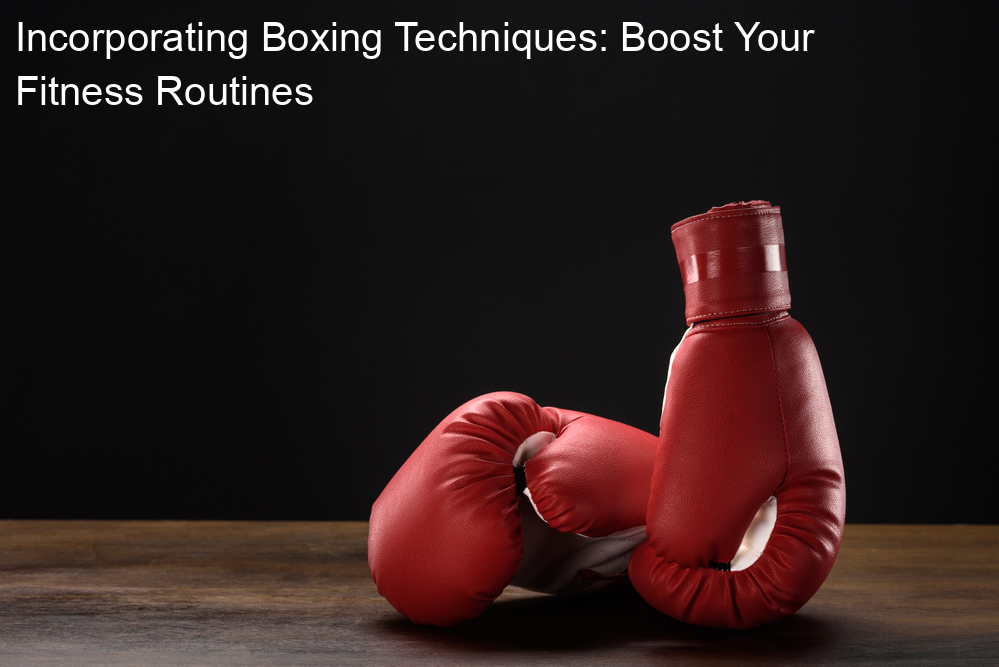Incorporating boxing techniques into fitness routines can be a game changer for those looking to switch up their workouts and boost their overall physical fitness.
Boxing is not just about throwing punches – it’s a whole-body workout that promotes strength, agility, and cardio endurance.
By integrating some of these powerful techniques, I have witnessed incredible transformations in both my body and mind, and I am confident that it can do the same for you.
Boxing is a versatile workout that can be adapted to fit various fitness levels and goals.
Whether you’re a beginner just starting out on your fitness journey or an experienced athlete seeking new challenges, there are specific boxing moves and techniques that can be incorporated to cater to your individual needs.
Not only will boxing help to improve strength and cardio, but it will also play a key role in enhancing balance and body control.
Key Takeaways
- Boxing techniques can boost overall physical fitness by improving strength, agility, and cardio endurance.
- Adaptable for various fitness levels, boxing moves and techniques cater to individual needs and goals.
- Incorporating boxing into workouts promotes better balance, body control, and core strength.
Understanding Boxing Techniques
I’ve always admired boxers like Muhammad Ali and Mike Tyson for their incredible skills and technique in the ring.
Incorporating boxing techniques into my fitness routine has not only made it more enjoyable but also highly effective.
In this section, I’ll briefly cover the basics of boxing and some popular techniques that form the core of a boxer’s arsenal.
The foundation of boxing starts with a proper stance. It’s important to find a comfortable and balanced position with your dominant foot at the back.
This helps in generating power and maintaining balance while executing punches. As a boxer, your basics come down to mastering four fundamental punches: jab, cross, hook, and uppercut.
The jab is the bread-and-butter punch of boxing. It’s a quick and simple straight punch thrown with your lead hand.
Beginner boxers will find it useful for keeping an opponent at a distance and setting up other punches.
The cross is a powerful and more offensive punch thrown with your rear hand.
It requires more commitment and power, as it endeavors to reach the opponent from a greater distance.
To generate force, pivot on the rear foot and use your hips to put your body weight into the strike.
The hook is a versatile punch that can be thrown with either the front or backhand. It targets the sides of your opponent’s head or body with a circular motion, allowing you to bypass their guard.
A front hook utilizes the lead hand, while a back hook makes use of the rear hand.
The uppercut is another valuable boxing technique that can be executed with the front or back hand, targeting the chin and body of your opponent.
A front uppercut is achieved using the lead hand, while a back uppercut utilizes the rear hand.
Rotate your hips and shoulder, then launch your fist in an upward motion to create the necessary power for both variations.
Lastly, practicing combinations will significantly enhance your boxing game. A common combination is a one-two punch consisting of a jab followed by a cross.
Additionally, learning to connect various punches together allows you to become a more unpredictable and effective boxer.
By incorporating these boxing techniques into my fitness routine, I feel more confident in my boxing abilities, and it’s added an element of excitement to my workouts.
Importance of Boxing in Fitness
As a fitness enthusiast, I find that incorporating boxing techniques into my fitness routine has significantly improved not only my physical abilities but also my mental well-being.
Boxing is an excellent way to engage various aspects of fitness, such as core strength, cardio, and endurance.
In my experience, boxing helps build a strong core, which is essential for overall body strength and stability.
The movement required in boxing, like twisting, helps to target the oblique muscles, providing a solid foundation for many other exercises.
Boxing is also an outstanding cardio and aerobic exercise. When I practice boxing, I notice that my heart rate increases, leading to better circulation and improved cardiovascular health.
This high-intensity workout burns calories, promotes weight loss, and helps to build lean muscle mass.
Endurance is another benefit I gained from boxing. As a high-intensity workout, it challenges my stamina, pushing me to stay active even when I feel tired.
This translates to better performance in other sports or activities, as I’m able to work through fatigue and stay focused.
Many athletes, including myself, use boxing techniques to build muscle and burn fat.
The fast-paced movements and explosive power required during boxing sessions allow for an effective weight-loss regimen and contribute to muscle growth.
When combined with a healthy diet and lifestyle, the results can be impressive.
The importance of boxing techniques in a fitness routine cannot be overstated. It improves core strength, cardio, endurance, muscle building, and weight loss.
It’s an all-encompassing workout that can be tailored to any fitness level, making it an ideal addition to anyone’s exercise regime.
Building a Boxing-Influenced Fitness Routine
I have found that incorporating boxing techniques into my fitness routine has been invigorating and challenging.
Here’s how I’ve built a boxing-influenced fitness routine that can be easily incorporated into your everyday life.
To start, I like to kick off my boxing workout with a warm-up run. Running not only helps to loosen up my muscles, but it also strengthens my cardiovascular endurance, which is vital in the sport of boxing.
I usually go for a 20-minute run, but you can adjust this based on your fitness level and preferences.
After my run, I head to the gym to focus on strength training. Boxing requires a strong core and upper body, so I make sure to incorporate exercises that target these areas.
I like to begin with bodyweight exercises such as push-ups, pull-ups, and planks. These are great for building a solid foundation and can be easily adjusted based on your ability.
I then move on to weights to further challenge my muscles. Exercises like shoulder presses, bicep curls, and rows complement the boxing movements nicely.
Once I’ve built up some strength, I incorporate more specific boxing workouts into my routine.
I start with shadowboxing – this helps me practice my technique and build muscle memory. I focus on footwork, head movement, and various punch combinations.
I find using a mirror particularly beneficial, as it allows me to visualize and correct my movements.
After shadowboxing, I move on to heavy bag training. This helps to build both strength and power in my punches while improving my conditioning.
I vary my workouts with a mix of drills, such as interval training, focusing on specific punch combinations and freestyle rounds.
This keeps my heavy bag sessions both challenging and dynamic.
Finally, I like to end my boxing workout with a cool-down session to help prevent injury and aid in recovery.
I usually engage in a few minutes of stretching or foam rolling, focusing on the muscles I used during the workout.
By incorporating these elements, I’ve successfully built a boxing-influenced fitness routine that keeps me engaged and motivated.
Give it a try and see how it can elevate your fitness journey!
Boxing Techniques for Different Fitness Levels
I believe that boxing is a fantastic sport that offers a variety of valuable techniques that can be incorporated into fitness routines for individuals of all levels.
Here, I want to discuss some of the boxing techniques that can be adapted for various fitness levels.
For beginners who are just starting their fitness journey, it is essential to focus on mastering basic boxing techniques like the jab and the straight right hand.
Practicing these punches will help you develop a solid foundation and understanding of the sport. Work on your footwork and shadowboxing to get a hang of the movement and rhythm.
Remember, start slow, and don’t push yourself too hard.
If you have been working out regularly and feel more comfortable with your physical abilities, you can start incorporating body shot combinations into your routine.
These include hooks and uppercuts to work on different muscle groups. At this intermediate level, you might consider trying out a heavy bag workout to build strength, endurance, and focus.
It is crucial to pay attention to proper form to avoid injuries and make the most of these techniques.
For advanced fitness enthusiasts, you can incorporate more complex boxing techniques such as slipping punches, counterpunching, and working with a speed bag.
These advanced techniques will challenge your agility, reflexes, and speed.
Also, consider incorporating plyometric exercises like jump squats and burpees into your routine to boost your overall explosiveness and stamina.
Incorporating boxing techniques into your fitness routine is a fantastic way to keep things fresh and exciting.
Remember to focus on proper form and gradually increase the intensity of your workouts as you become more comfortable with these skills.
Enjoy the process, and always listen to your body! I’m sure you’ll find boxing techniques to be a fun and effective addition to your fitness journey.
Specific Boxing Moves to Incorporate
Incorporating boxing techniques into my fitness routine has been a game-changer for me. It adds variety, improves coordination, and helps build strength.
I’d like to share some specific boxing moves that you can incorporate into your workouts as well.
One fundamental boxing move is the jab. This simple punch is thrown with your leading hand in a straight line, targeting your opponent’s face or body.
I like to incorporate jabs into my routine as a warm-up or as part of a conditioning circuit.
Next up is the cross. This powerful punch is thrown with your rear hand and can target the head or body of your opponent.
The cross requires good hip rotation, making it an excellent full-body workout. Incorporating crosses into my routine has helped me improve my strength and power.
Hooks are another useful boxing move to incorporate. They are short, powerful punches that are thrown with a bent arm, aiming at the sides of your opponent’s head or body.
I’ve found that adding hooks to my routine has improved my core strength and overall coordination.
Uppercuts are upward punches that are thrown with either hand, targeting the chin or torso of your opponent.
Personally, I like adding uppercuts into my fitness routine, specifically targeting the heavy bag.
It helps me focus on my upper body strength and conditioning.
In addition to these single punches, remember that combining different boxing moves into combinations can be a great way to enhance your workouts.
Further, incorporating footwork, head movement, and defensive techniques will help create a well-rounded routine that challenges multiple aspects of your fitness.
Adding jabs, crosses, hooks, uppercuts, and other boxing moves into your fitness routine will not only keep things interesting, but they’ll also help you develop strength, coordination, and overall athleticism.
Give these moves a try and see how they can enhance your workouts!
Tools and Equipment for Boxing Established Fitness
Incorporating boxing techniques into my fitness routine has been a game-changer for both my strength and cardiovascular health.
With a few essential tools and equipment, I’ve managed to create an effective workout setup right at home.
Let me share with you some of these essential items.
First up, we have gloves. Boxing gloves are crucial to protect my hands and wrists from injury during intense workout sessions.
Various types of gloves are available, such as bag gloves for heavy bag training, sparring gloves for partner practice, and even hybrid styles suitable for both purposes.
When choosing gloves, I make sure they fit snugly and provide appropriate wrist support.
Next, we have the punching bag. A crucial component for practicing punches, the punching bag can be found in different styles like heavy bags, uppercut bags, and reflex bags.
I personally prefer using a heavy bag, as it helps me develop power and proper technique. When choosing a punching bag,
I consider factors such as the bag’s weight, size, and required mounting setup.
Lastly, light dumbbells are a great addition to my boxing fitness routine. They help me build strength, speed, and precision in my upper body while throwing punches.
I usually opt for dumbbells weighing 1-3 pounds and incorporate them into shadowboxing or other boxing-specific exercises.
To sum up, incorporating boxing techniques into my fitness routine has been greatly enhanced by having the right tools and equipment.
Investing in good gloves, a suitable punching bag, and light dumbbells allows me to practice safely and effectively while reaping the benefits of boxing for my overall fitness.
Boxing Techniques for Core and Strength Building
I love incorporating boxing techniques into my fitness routines because they help me develop my core muscles, arms, legs, and abs all at once.
Also, they add some fun and excitement to the usual gym exercises. One of the best techniques for core and strength building is shadowboxing.
I usually start my workout with a simple 3-minute round of shadowboxing to warm up and engage my core muscles.
I make sure to keep my hands up, rotate my hips, and maintain good footwork. This activity not only helps with building strength but also improves my boxing technique.
Another great technique for working on my core and strength is the heavy bag workout. I use a timer, set it for 2-3 minute rounds, and alternate between different punching combinations.
For instance, I throw straight punches, hooks, uppercuts, and body shots, focusing on my technique, accuracy, and power.
Using heavy bags challenges my arms, legs, and core muscles, making it an effective full-body workout.
In addition to these basic techniques, I sometimes integrate weights into my boxing workouts to help build strength.
For example, I’ll wear weighted gloves or wrist weights while shadowboxing or hitting a heavy bag.
This extra resistance pushes me to work harder and develop more muscle in my arms, legs, and core.
Lastly, I like incorporating bodyweight exercises that target specific muscle groups. To focus on my abs, I do Russian twists with a medicine ball after my boxing workouts.
For my arms and shoulders, push-ups and dips are excellent choices.
Integrating boxing techniques into my fitness routine has been a game-changer for me.
It helps me build core strength, improves my overall physical endurance, and keeps me mentally engaged while working out.
Incorporating Boxing into Cardio and Fat Burning Exercises
When I’m looking for a fun and effective way to boost my cardio and burn calories, incorporating boxing techniques into my fitness routine is my go-to choice.
Let me share with you how I use boxing to improve cardiovascular fitness and maximize fat burning.
First, here’s a simple boxing-based cardio workout:
- Warm-up: Jump rope for 5 minutes to get the heart rate up and prepare the body for exercise.
- Shadowboxing: Spend 10 minutes practicing different punches (jabs, crosses, hooks, and uppercuts) and footwork (advancing, retreating, and pivoting) while maintaining a steady rhythm.
- High-intensity intervals: Perform 30 seconds of all-out punching on a heavy bag or focus mitts, followed by 30 seconds of active rest (light jogging in place or a brisk walk). Repeat this sequence for a total of ten rounds.
- Cool down: Slowly lower the heart rate with 5 minutes of light stretching and deep breathing exercises.
This simple yet effective workout allows me to elevate my heart rate, improve aerobic capacity, and consistently burn calories, leading to effective fat burning.
One of the aspects I love about incorporating boxing into my cardio routine is the way it engages multiple muscle groups.
When I throw punches, I’m not only working my arms but also my shoulders, back, chest, core, and legs.
This full-body workout helps me burn more calories not only during the workout but also long after it, thanks to the afterburn effect.
To keep things fresh and engaging, I occasionally swap out traditional cardio exercises with boxing drills.
For instance, I replace sprints with fast-paced punching intervals or substitute burpees with ‘punch and sprawl’ exercises.
Mixing up my workouts in this manner helps me stay motivated and prevents workout plateaus while still keeping a fat-burning focus.
Incorporating boxing techniques into my fitness routine has proven to be a fantastic way to add variety, boost cardio, and burn calories effectively.
If you’re looking for a fun, challenging, and rewarding way to improve your cardiovascular endurance and shed some fat, give boxing a try!
The Role of Boxing Presented Techniques in Body Balance and Agility
As a fitness enthusiast, I’ve found that incorporating boxing techniques into my routine has greatly improved my body balance and agility.
Boxing is more than just throwing punches—it’s a full-body workout that challenges your muscles, coordination, and cardiovascular endurance.
One aspect of boxing that has greatly improved my balance is the footwork.
Practicing various footwork drills has taught me how to shift my weight efficiently and maintain stability while moving in multiple directions.
The constant movement in boxing—forward, backward, and side-to-side—also aids in developing better body awareness, which directly translates to improved balance.
Agility is another key component of boxing. Quick, responsive movements are the foundation of the sport.
Personally, I’ve found that incorporating boxing-specific agility drills into my routine has greatly increased my ability to change directions quickly and smoothly.
Ladder drills and cone exercises are great for improving agility and foot speed. But remember, as with any workout, it’s important not to overdo it—a moderate, consistent pace is the key to seeing improvement.
Incorporating boxing techniques into your fitness routine can be as simple or as complex as desired.
Using basic shadowboxing or practicing combinations on a heavy bag are effective ways to work on balance and agility.
For those looking for a more challenging workout, sparring with a partner or participating in a boxing-inspired group fitness class are excellent ways to put these skills into practice.
With consistent practice, boxing techniques can make a significant difference in body balance and agility.
The fusion of these skills into my fitness routine has not only made me a better athlete but it’s also brought an enjoyable challenge to my workouts.
If you’re looking to switch things up and add a new dimension to your fitness journey, consider incorporating boxing techniques into your routine.
Safety and Injury Considerations
As someone who’s passionate about fitness, I want to stress the importance of safety when incorporating boxing techniques into your routines.
Injuries can happen, but with a few precautions, we can minimize the risks.
First, it’s crucial to invest in proper gear like hand wraps, gloves, and mouth guards. Hand wraps protect your wrists and knuckles, while gloves help absorb shock.
A mouth guard, on the other hand, can prevent dental damage during those intense sessions.
Second, always prioritize proper form when executing boxing moves. Bad form can lead to injuries like sprains, strains, and even fractures.
It’s good to start with a qualified trainer who can correct mistakes early on and ensure you’re learning the right techniques.
Beyond that, a well-planned warm-up before each session can help prevent injuries.
Incorporate dynamic stretches, like leg swings and arm circles, and focus on your major muscle groups and joints.
This prepares your body for the intense workout that follows.
Lastly, listen to your body and know your limits. Overexertion may lead to muscle fatigue, which increases your risk of injury.
It’s crucial to give your body time to rest and recover; don’t push yourself too much.
By following these safety and injury considerations, you’re more likely to enjoy boxing-based fitness routines and reach your goals while minimizing potential setbacks.
Incorporating Rest and Recovery
When it comes to incorporating boxing techniques into our fitness routines, it’s essential to give ourselves time to rest and recover.
Recovery is just as important as the workouts themselves, as it allows our muscles to repair and grow stronger.
I make sure to have a day of rest between intense boxing workouts. By doing so, I give my muscles enough time to recuperate, preventing injuries and overtraining.
During these rest days, I like to engage in light activities such as stretching, yoga, or a leisurely walk, ensuring that I’m staying active without overexerting myself.
Sleep is another crucial aspect of rest and recovery. I aim for 7-9 hours of quality sleep every night to give my body the time it needs to heal and reset.
A consistent sleep schedule helps maintain hormonal balance, which plays a vital role in the overall recovery process and boosts my performance during boxing workouts.
Nutrition also plays a part in the rest and recovery process. I make sure to consume a balanced diet with adequate protein, carbs, and healthy fats that provide the necessary nutrients for muscle repair.
Staying hydrated is essential as well, so I drink plenty of water throughout the day to optimize recovery.
Lastly, I pay attention to how my body feels and take additional rest days when needed.
Listening to our bodies is key, as it helps us identify any signs of stress or fatigue that may require more downtime.
Incorporating rest and recovery into our boxing fitness routines is crucial for our overall health and progress.
By taking care of ourselves and giving our bodies the proper rest they need, we can enjoy the long-term benefits of our workouts.
Relevance of Boxing Weather Conditions in Workout
As a fitness enthusiast, I’ve found that incorporating boxing techniques into my workout routines is not only a great way to switch things up but also a fantastic way to challenge my body and improve my overall fitness.
One aspect that is often overlooked when discussing boxing workouts is the relevance of weather conditions.
I’ve noticed how weather can impact my boxing workouts in various ways. On hot and humid days, I tend to sweat more which can affect my grip on the gloves or the punching bag.
As a result, I make sure to keep a towel and some chalk handy to wipe away sweat and improve my grip.
I also find that staying hydrated is especially important during these conditions to prevent fatigue and cramping.
On colder days, warming up properly becomes crucial to avoid injury and ensure my muscles and joints are ready for the intense movements that boxing workouts entail.
I usually start with some dynamic stretching and light cardio to increase my heart rate and warm up my muscles before diving into the boxing drills.
Rainy conditions can sometimes pose challenges, especially when training outdoors.
Slippery surfaces can make footwork and movement more difficult, so I make sure to wear shoes with a good grip to avoid any slips or falls.
Furthermore, training in the rain can be an interesting way to improve focus and mental resilience, as it forces me to block out distractions and stay engaged in my workout.
Being mindful of the weather conditions and adapting my boxing workouts accordingly has not only helped me stay safe and prevent injury but also allowed me to discover new ways to challenge myself and improve as a boxer.
Seeking Professional Help
As I started incorporating boxing techniques into my fitness routine, I quickly realized the importance of seeking professional help.
A qualified trainer can not only ensure that I learn the proper techniques but also help me avoid injuries.
In my experience, working with a boxing trainer has improved my understanding of the sport and helped me develop a more well-rounded fitness routine.
They provided guidance on proper footwork, punching technique, and defensive strategies. This professional guidance has made my fitness sessions more enjoyable and effective.
Another aspect that I found valuable with a trainer is the opportunity to spar.
Sparring sessions allow me to practice my skills in a controlled environment and receive real-time feedback from my trainer.
This hands-on practice is crucial in sharpening my techniques and building my confidence in applying them.
To find a boxing trainer, I recommend visiting local gyms and boxing clubs. Many trainers offer private or group sessions, depending on your preferences and budget.
In my journey, it was important to find a trainer who was not only knowledgeable but also approachable and patient.
Incorporating boxing techniques into my fitness routine has been highly effective and enjoyable.
Seeking professional help in the form of a qualified trainer has made all the difference in my progress.
With their guidance and encouragement, I’ve been able to level up my fitness game while learning a new sport.
Conclusion
Incorporating boxing techniques into my fitness routine has been both enjoyable and effective.
The combination of cardio, strength, and agility training creates a dynamic workout that challenges my body in a new way.
Moreover, practicing these techniques helps improve mental focus and self-discipline as well.
I’ve personally noticed improved endurance, strength, and balance since adding boxing elements to my workouts.
Also, it’s a fantastic stress reliever, allowing me to release tension while also getting in shape. The best part is that boxing techniques are versatile, making them perfect for incorporating into various types of fitness routines.
In the end, trying out boxing techniques in my fitness routine has been a game-changer. I feel more powerful, agile, and well-rounded as an athlete.
So, if you’re looking for a fresh, fun, and effective way to enhance your workouts, give boxing techniques a try — you won’t be disappointed!
Frequently Asked Questions
What are some effective boxing exercises for muscle development?
I find that a combination of punches, core exercises, and strength training can effectively work your muscles in a boxing workout.
Start with basic punches like jabs, crosses, hooks, and uppercuts to target your biceps, triceps, and shoulders. Incorporate planks, sit-ups, and Russian twists for a strong core.
Finally, include exercises such as push-ups, pull-ups, and squats to develop overall strength and power.
How can I create a fun boxing workout with a partner?
A fun partner boxing workout can involve pad work, sparring, or incorporating relay-style exercises.
One of my favorite partner drills is “punch catch,” where one person throws a series of punches, and the other person catches them with open palms.
This helps both partners improve their offense and defense skills. Further, you can create friendly competitions with exercises like speed punching or race-style obstacle courses.
What does a typical weekly boxing training schedule look like?
My weekly boxing schedule usually consists of cardio, strength training, and technique work.
I like to dedicate at least three days a week to boxing workouts that include shadowboxing, heavy bag work, and mitt work, focusing on improving my speed, power, and accuracy.
On alternate days, I do cardio exercises such as running, skipping, or circuit training and incorporate one to two days of strength and conditioning work.
Can you suggest some challenging boxing circuits?
Challenging boxing circuits can include high-intensity interval training (HIIT) exercises.
An example of a circuit I often do consists of: 1 minute of fast punching, 30 seconds of burpees, 1 minute of uppercuts, 30 seconds of mountain climbers, and 1 minute of hooks, followed by 30 seconds of jumping squats.
Repeat this circuit three to four times with a 1-minute rest between each round.
What are some at-home boxing workouts for fitness?
For at-home boxing workouts, I’d recommend using a freestanding punching bag or investing in a pair of focus pads.
Warm up with some shadowboxing, and then proceed to heavy bag work or pad work, focusing on combinations and footwork.
Incorporate bodyweight exercises like push-ups, sit-ups, and squats, and conclude your workout with a cooldown stretch.
How can a boxing workout routine improve my overall exercise regimen?
Adding a boxing workout routine to your existing exercise regimen can enhance your overall fitness. I find that boxing helps improve cardiovascular endurance, strength, coordination, and agility.
The high-intensity nature of boxing workouts increases calorie burning and fat loss. Incorporating boxing into your routine also keeps it diverse and engaging, preventing boredom and plateaus.






